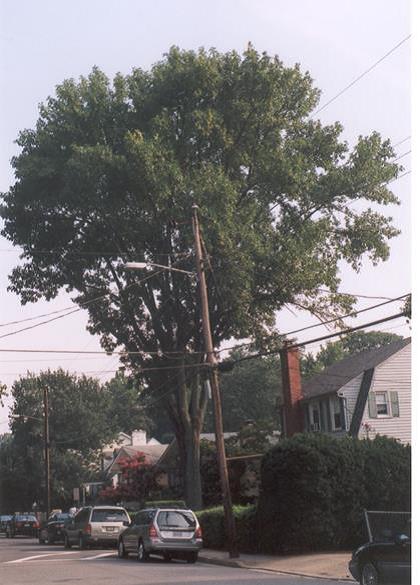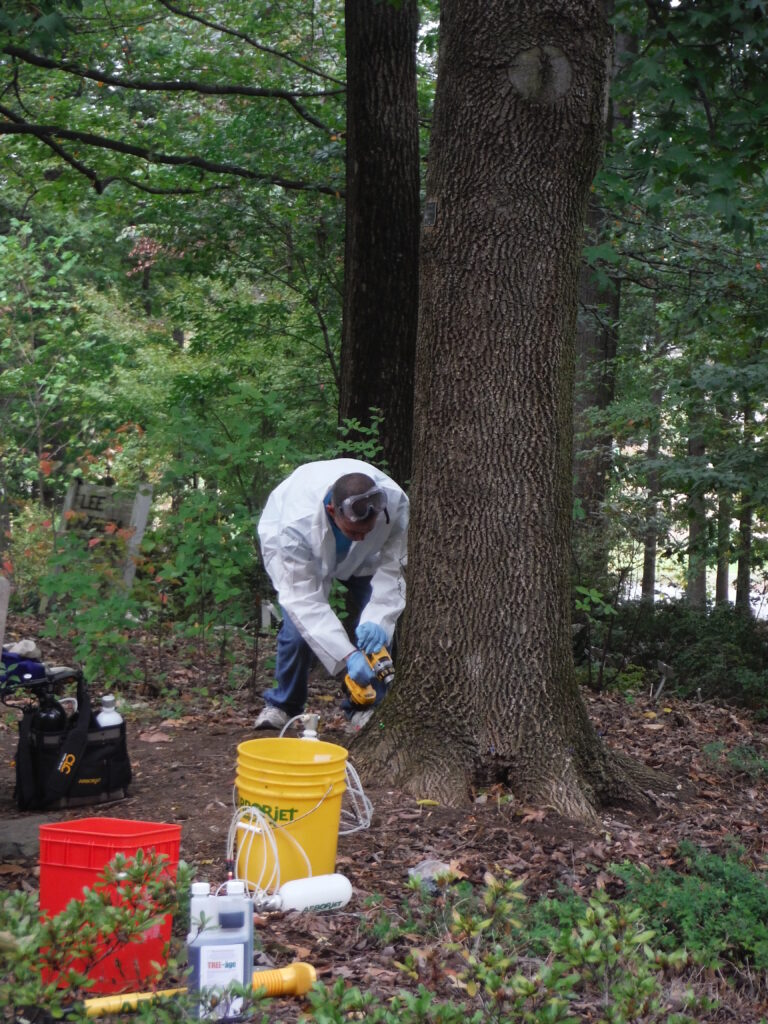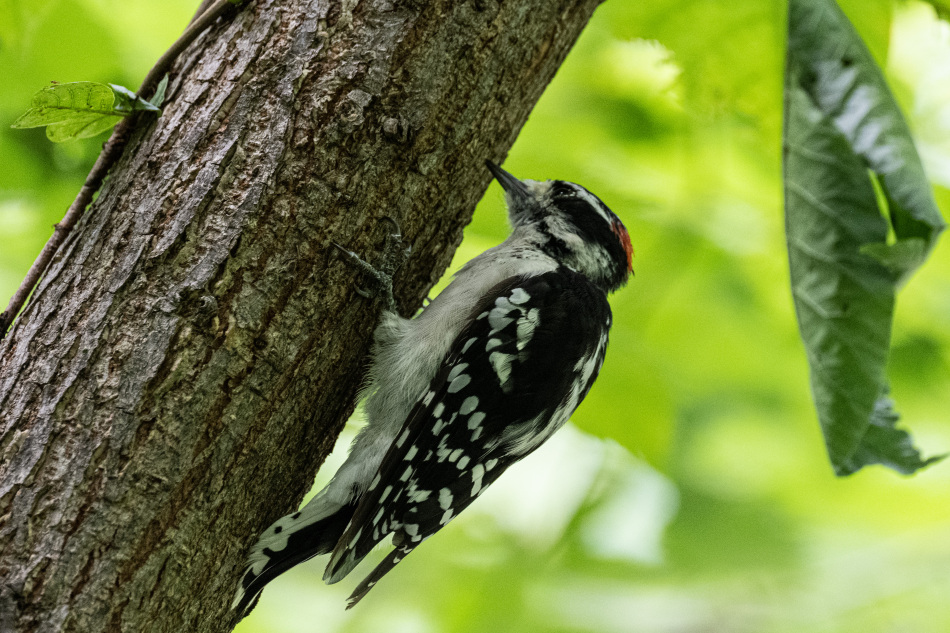As we know, survival of North American species of ash (Fraxinus spp.) is threatened by the emerald ash borer (EAB). DMF Sadof, McCullough, and Ginzel (full citation at end of the blog) hope to prevent demise of another ~ 135 million urban ash trees by 2050 bycountering persistent myths that have hindered adoption of effective protective measures. As they note, USDA APHIS has dropped regulations that had been intended to slow the EAB’s spread – which I concede were not very effective.
Protecting urban ash trees now falls to municipalities, states, their leaders and citizens, non-governmental organizations, and tree care professionals. If they apply knowledge gained since the detection of EAB 20 years ago – and are not paralyzed by myths – they can successfully manage EAB populations and protect their town’s ash trees. [I have also blogged about efforts to breed ash trees resistant to EAB.]
Since some studies have found that “myth-busting” is not effective, perhaps people advocating for EAB control should avoid mentioning the myths per se and instead emphasize the science supporting the proposed actions.
Sadof, McCullough, and Ginzel first review aspects of the biology of ash and EAB that are relevant to arborists and pest management specialists:
- Adult EAB beetles feed on tree leaves for a couple of weeks from mid-May through June. This maturation period provides a 2–3 week opportunity to kill the leaf-feeding beetles with systemic insecticides before any eggs are laid.
- Once eggs hatch, the first stage larvae immediately move into the phloem (inner bark) and cambium tissue, where they begin feeding. Systemic insecticides rarely enter the phloem, so they kill few larvae during this stage.
- Detection of early stages of invasion is hampered by several factors, including beetles’ initial colonization of branches in the upper canopy; initially minimal effect on healthy ash trees; and the frequency of two-year life cycles when beetle densities are low. However, it is important to detect and treat these early infestations because EAB populations increase, tree health declines to eventual death.
- Detection efforts should target the ash trees most likely to be infested early in the invasion: stressed trees, preferred species (especially green ash), trees growing in the open in parks, along roadsides or surrounded by impervious surfaces. Authorities can take advantage of the attractiveness of stressed trees by establishing “trap trees” to attract EAB adults. Beetles that feed on the “trap trees” can be killed by systemic insecticides. Or the trees can be removed and chipped to kill eggs and larvae before they can emerge. Sadof, McCullough, and Ginzel say trap trees are effective in slowing spread of new infestations when most ash trees remain healthy. Once EAB densities build and many trees are stressed by larval feeding, volatile (airborne) compounds released by girdled trees no longer attract the beetles.
- Woodpecker holes in branches of the upper canopy are often the first evidence of EAB invasion in an area.
- Even in late stages of the invasion, when most ash trees that were not protected with systemic insecticides are dead, EAB populations persist and continue to colonize and kill available ash trees, including some as small as >2.5 cm in diameter.
Myth: There Is No Point in Trying to Protect Ash Trees—
EAB Will Eventually Kill Them Anyway
Answer:
When the EAB was first detected in 2002, control measures were limited in number and efficacy. In the 20 intervening years, scientist have learned much about EAB biology and ash physiology. Insecticide chemistry and application methods have improved. Currently recommended strategies are based on long-term field studies. More effective insecticides have been developed. Emamectin benzoate is particularly efficient, including the fact that it needs to be applied only every third year. Managers must pay attention to the application protocols, including appropriate dose (i.e., the amount of insecticide product applied); spacing injection ports around the trunk to ensure that the xylem will transport the chemical to leaves throughout the canopy; and conduct injections in spring after bud break.
Myth: Wounds From Drilling Trees to Inject Systemic Insecticides Injure Trees
Answer:
In the early years, trunk injections sometimes caused substantial injury to trees. Refinement of delivery devices and reductions in the pressure at which insecticides are injected have virtually eliminated these issues. Staff must be properly trained in use of the equipment.
Myth: Using Systemic Insecticides to Protect Ash Trees Harms
Non-target Species and the Environment
Answer:
Sadof, McCullough, and Ginzel point out that continent-wide loss of a tree genus is likely to adversely affect the more than 200 species of native arthropods that are specialists on ash. On the other hand, systemic insecticides are unlikely to harm beneficial natural enemies of EAB, including parasitoid wasps, predatory insects, or woodpeckers. First, the insecticides are contained within the tree’s tissues; they do not kill insects on contact. Second, parasitoids and predators avoid dead beetles. Honeydew excreted by sucking insects might contain sufficient insecticide residue to harm parasitoids — if the tree is heavily infested. However, these insects are rapidly killed by these insecticides if they are applied at the optimal time (early to mid-spring). Proper timing of application greatly reduces the potential for tainted honeydew to accumulate on infested trees. Furthermore, in cities there are few populations of natural enemies of sucking insects.
Most concern is focused on pollinators. Ash trees flower early, before leaves expand. It is reassuring that protocols instruct that the systemic insecticides be applied after bud break — typically after pollen has been shed. I do find it disturbing that apparently there have been no published studies of insecticide concentration in ash pollen.
Myth: It Costs Too Much to Protect Ash Trees
Answer:
Sadof, McCullough, and Ginzel review the several studies and methods developed to estimate the value of urban ash trees – both individually and over a wider area. The value is based on the individual tree’s location, health, and structural condition. These economic studies have consistently shown that it costs less to protect ash trees from EAB with insecticide treatments than to remove ash trees — either proactively or when they decline and die.
Even delaying tree mortality – short of preventing it completely – is worthwhile because it allows municipalities to incorporate tree removal into the budget, rather than be suddenly confronted by large expense that they had not planned for.
Sadof, McCullough, and Ginzel recommend treating ash within a significant area as being most efficient. This approach reduces overall costs and slows rates of ash mortality locally – even for trees that are not treated. In some cases, treating as few as 11% of ash trees slowed the overall rate of ash decline.
An important in comparing costs of treatment to costs of replacement is the high mortality rate of newly planted urban trees: up to two-thirds die shortly after planting. This means that it takes decades to replace a mature tree canopy and the environmental benefits the canopy provides. Sadof, McCullough, and Ginzel conclude that protecting ash trees from EAB has clear positive effects for both the urban forest canopy – and its environmental services – and municipal forestry budgets.
Sadof, McCullough, and Ginzel then outline a viable Integrated Pest Management (IPM) framework that incorporates use of systemic insecticides to protect ash trees from EAB.
1. Define the problem and identify management objectives
Inventory urban trees before EAB is detected. The inventories should identify priority trees based on size (diameter at breast height), tree condition, and suitability of the site where the tree is growing. Focus detection surveillance on green ash trees, especially those in parks, parking lots, and along roads — sites that are sunlit (open) and likely to cause stress to the trees.
2. Monitor and assess the local EAB population to determine when a treatment program should be initiated. Treatment must wait until there is evidence that EAB is present but should not then be delayed, since it should begin while the trees’ vascular systems are still sufficiently healthy to carry the insecticide to branches and leaves. This requires regular inspections of ash trees for visible signs of EAB infestation. Efficiency is improved by focusing on high-risk trees (see above) and noticing woodpecker holes on upper portions of the trunk. Consider debarking symptomatic trees or establishing “trap tree” networks.
3. Identify and gather resources needed to implement an insecticide treatment program. Web-based calculators guide budget decisions based on the municipality’s tree inventory and local costs of treatments. Treating one-third of trees annually with emamectin benzoate can save money while maximizing the number of trees protected. Training city forestry staff in trunk injection methods is cheaper than hiring contractors and ensures better treatment quality and efficiency.
4. Incorporate multiple tactics to protect tree health and control EAB.
Ensure trees are actively transpiring when injecting the systemic insecticides; this might require irrigation. Encourage parasitoids and woodpecker foraging on untreated trees. In areas where ash trees are closely spaced, consider an area-wide urban SLAM program. In this strategy, treating a proportion of ash trees at two-year intervals reduces EAB eggs and overall EAB populations. Non-treated trees with EAB larvae might support parasitoid biocontrol populations whose offspring can attack EAB larvae on previously treated ash trees as the emamectin benzoate concentration wanes.
Sadof, McCullough, and Ginzel also suggest establishing a citizen monitoring program to both reduce costs and build community support for ash management. Community participation has been particularly effective when professionals take appropriate and timely action in response to volunteers’ findings.
SOURCE
Sadof, C.S., D.G. McCullough, and M.D. Ginzel. 2023. Urban ash management and emerald ash borer (Coleoptera: Buprestidae): facts, myths, and an operational synthesis. Journal of Integrated Pest Management, 2023, Vol. 14, No. 1 https://doi.org/10.1093/jipm/pmad012
Posted by Faith Campbell
We welcome comments that supplement or correct factual information, suggest new approaches, or promote thoughtful consideration. We post comments that disagree with us — but not those we judge to be not civil or inflammatory.
For a detailed discussion of the policies and practices that have allowed these pests to enter and spread – and that do not promote effective restoration strategies – review the Fading Forests report at http://treeimprovement.utk.edu/FadingForests.htm
or


